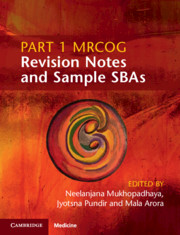Book contents
- Part 1 MRCOG Revision Notes and Sample SBAs
- Part 1 MRCOG Revision Notes and Sample SBAs
- Copyright page
- Dedication
- Contents
- Contributors
- Introduction
- Section 1 Anatomy
- Section 2 Embryology
- Section 3 Physiology
- Section 4 Genetics
- Section 5 Endocrinology
- Section 6 Biochemistry
- Section 7 Pathology
- Chapter 38 Pathology of Clinical Sepsis
- Chapter 39 Histopathology of Female Organs, Including Pituitary and Hypothalamus
- Chapter 40 Placental Site Implantation
- Chapter 41 Teratogenesis
- Chapter 42 Pathological Conditions Related to the Uterus, Tubes and Ovaries
- Chapter 43 Gynaecological Cancers
- Chapter 44 Pathophysiology of Pain
- Chapter 45 Pathology of the Bladder, Urethra and Vagina
- Section 8 Clinical Management and Data Interpretation
- Section 9 Pharmacology
- Section 10 Microbiology
- Section 11 Immunology
- Section 12 Biophysics
- Section 13 Epidemiology and Statistics
- Appendices:Practice Question Papers with Answers
- Index
Chapter 45 - Pathology of the Bladder, Urethra and Vagina
from Section 7 - Pathology
Published online by Cambridge University Press: 24 November 2020
- Part 1 MRCOG Revision Notes and Sample SBAs
- Part 1 MRCOG Revision Notes and Sample SBAs
- Copyright page
- Dedication
- Contents
- Contributors
- Introduction
- Section 1 Anatomy
- Section 2 Embryology
- Section 3 Physiology
- Section 4 Genetics
- Section 5 Endocrinology
- Section 6 Biochemistry
- Section 7 Pathology
- Chapter 38 Pathology of Clinical Sepsis
- Chapter 39 Histopathology of Female Organs, Including Pituitary and Hypothalamus
- Chapter 40 Placental Site Implantation
- Chapter 41 Teratogenesis
- Chapter 42 Pathological Conditions Related to the Uterus, Tubes and Ovaries
- Chapter 43 Gynaecological Cancers
- Chapter 44 Pathophysiology of Pain
- Chapter 45 Pathology of the Bladder, Urethra and Vagina
- Section 8 Clinical Management and Data Interpretation
- Section 9 Pharmacology
- Section 10 Microbiology
- Section 11 Immunology
- Section 12 Biophysics
- Section 13 Epidemiology and Statistics
- Appendices:Practice Question Papers with Answers
- Index
Summary
Cystitis: Acute bladder inflammation is usually caused by coliforms and is associated with infections of the urethra and vagina. Communication with the gut predisposes to anaerobic bacterial infection. Granulomatous inflammation is seen with Mycobacterium Tuberculosis in association with renal tuberculosis and in patients with bladder carcinoma who have received Bacillus Calmette-Guerin (BCG) immunotherapy. Schistosomia Hematobium-associated inflammation predisposes to squamous cell carcinoma (SCC) of the bladder. Interstitial cystitis, commonly seen in middle-aged women, is characterised by tiny pinpoint haemorrhages on the bladder wall. The associated painful bladder syndrome is poorly understood and variably attributed to autoimmunity, unidentified allergies, unidentified infectious agents, increased cytotoxicity to cationic metabolites, defective surface epithelial layer function, role of mast cells and genetic predisposition, among others. Emphysematous cystitis is associated with immune-compromised states, uncontrolled diabetes and neurogenic bladder, and shows gas-filled cysts. Classic haemorrhagic cystitis is a side effect of cyclophosphamide therapy.
- Type
- Chapter
- Information
- Part 1 MRCOG Revision Notes and Sample SBAs , pp. 278 - 280Publisher: Cambridge University PressPrint publication year: 2020



